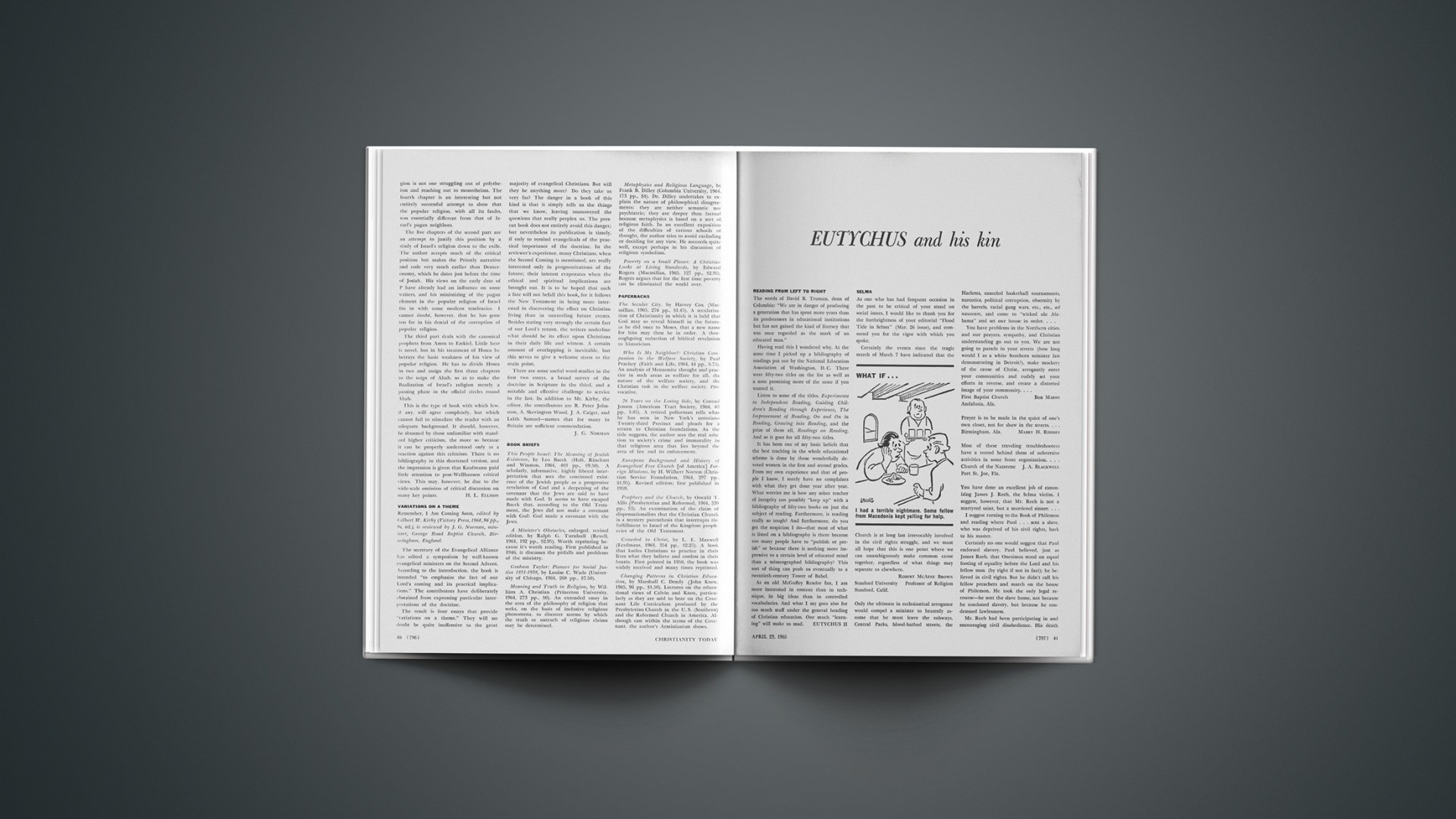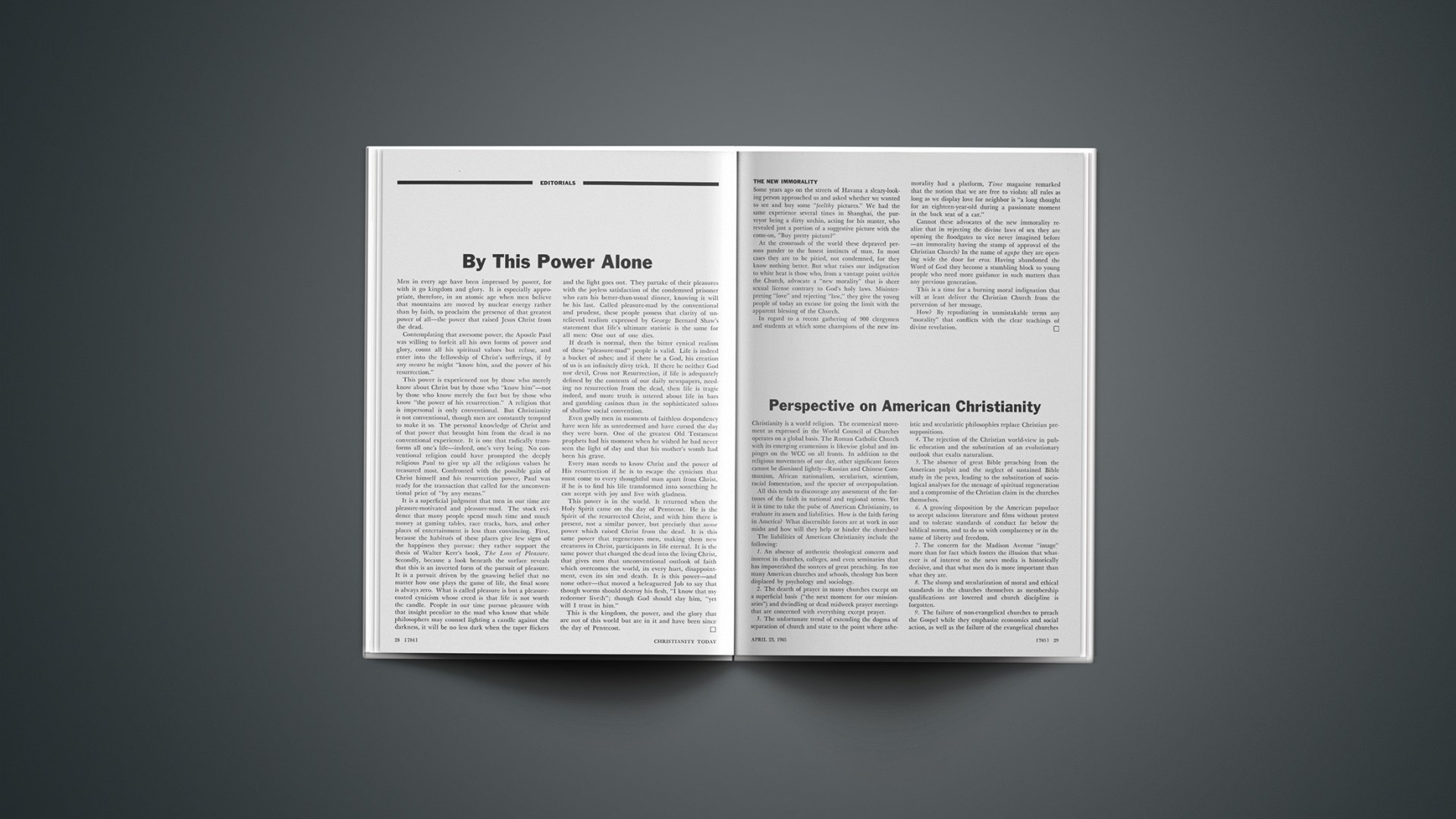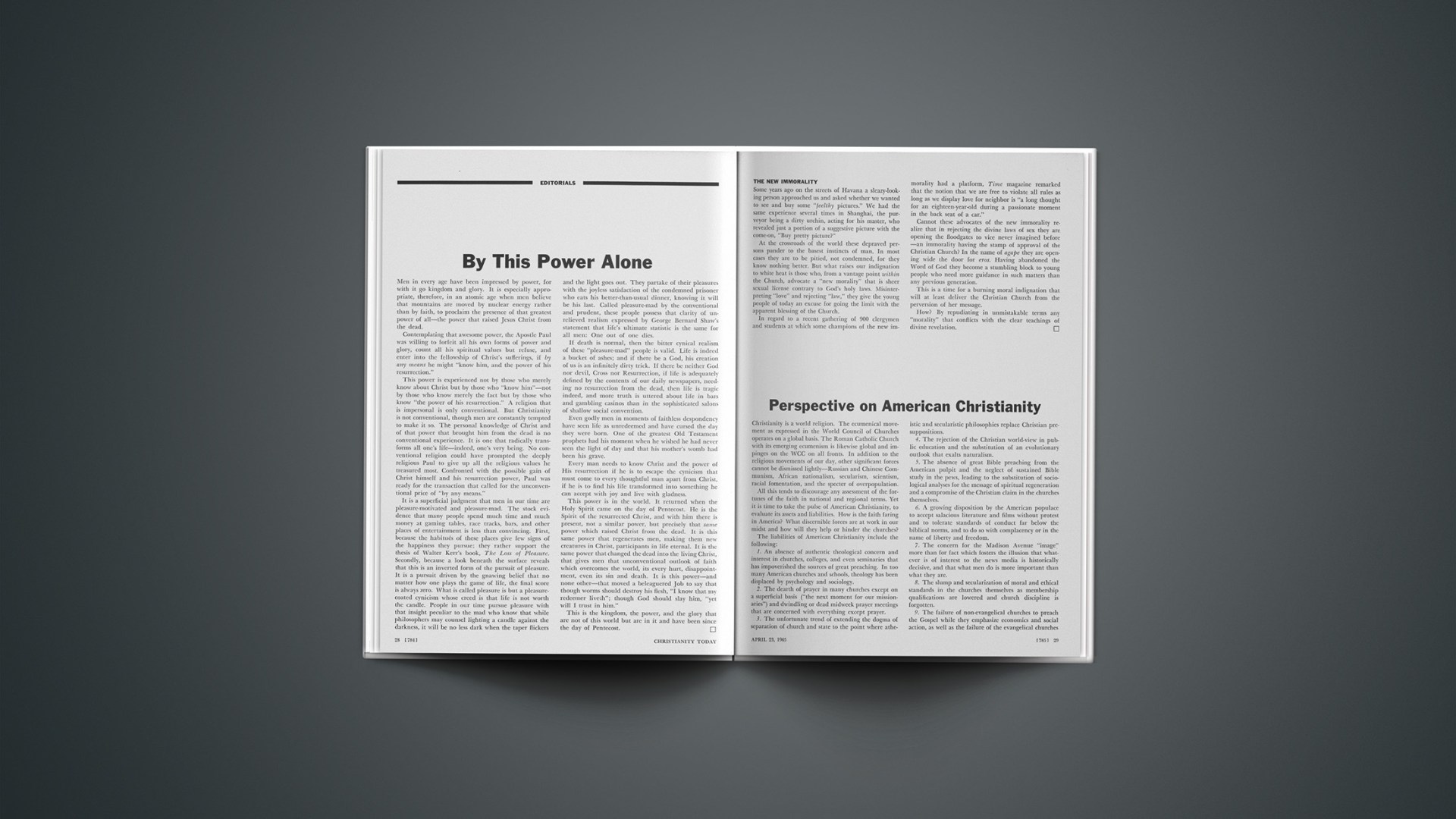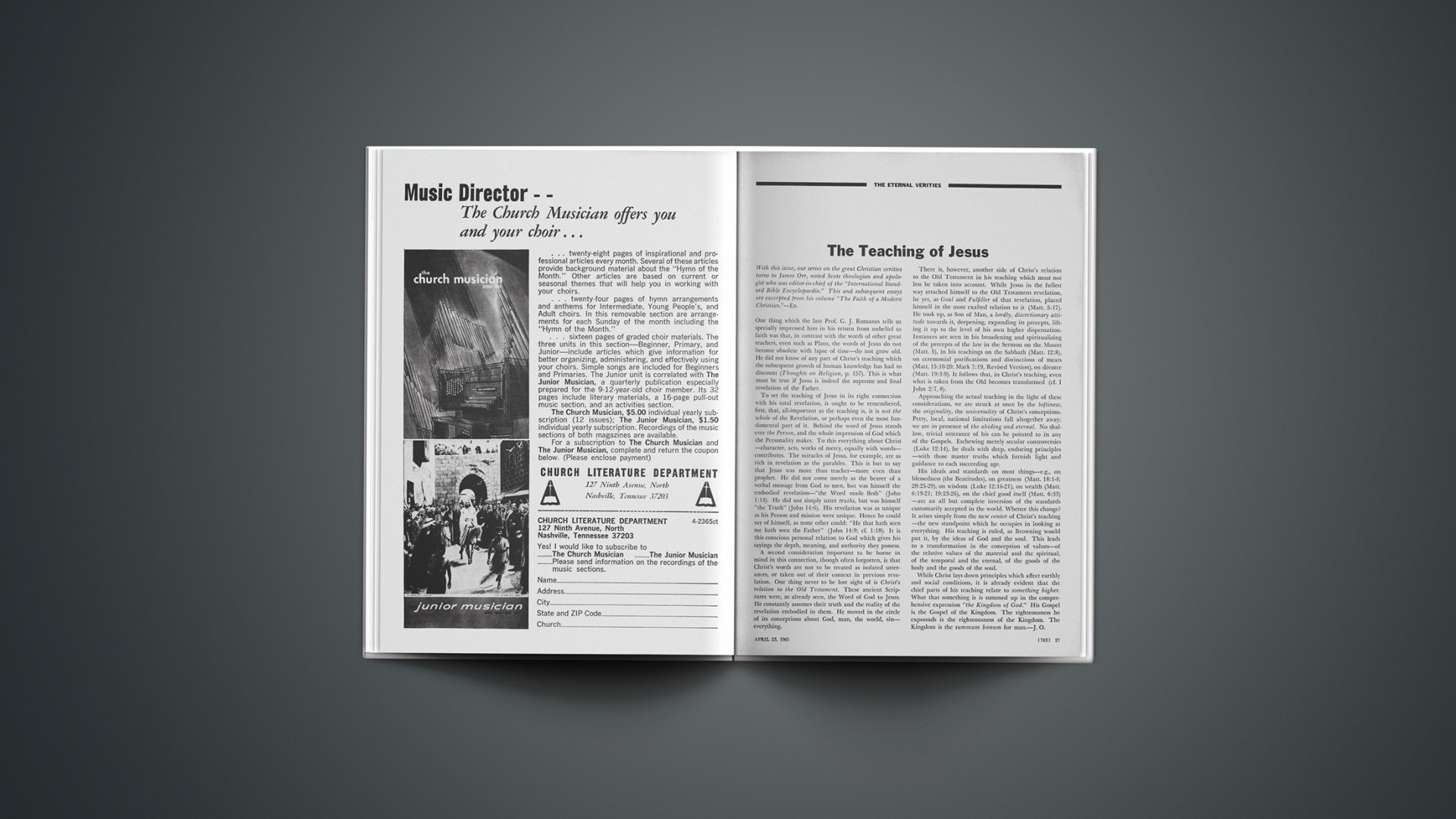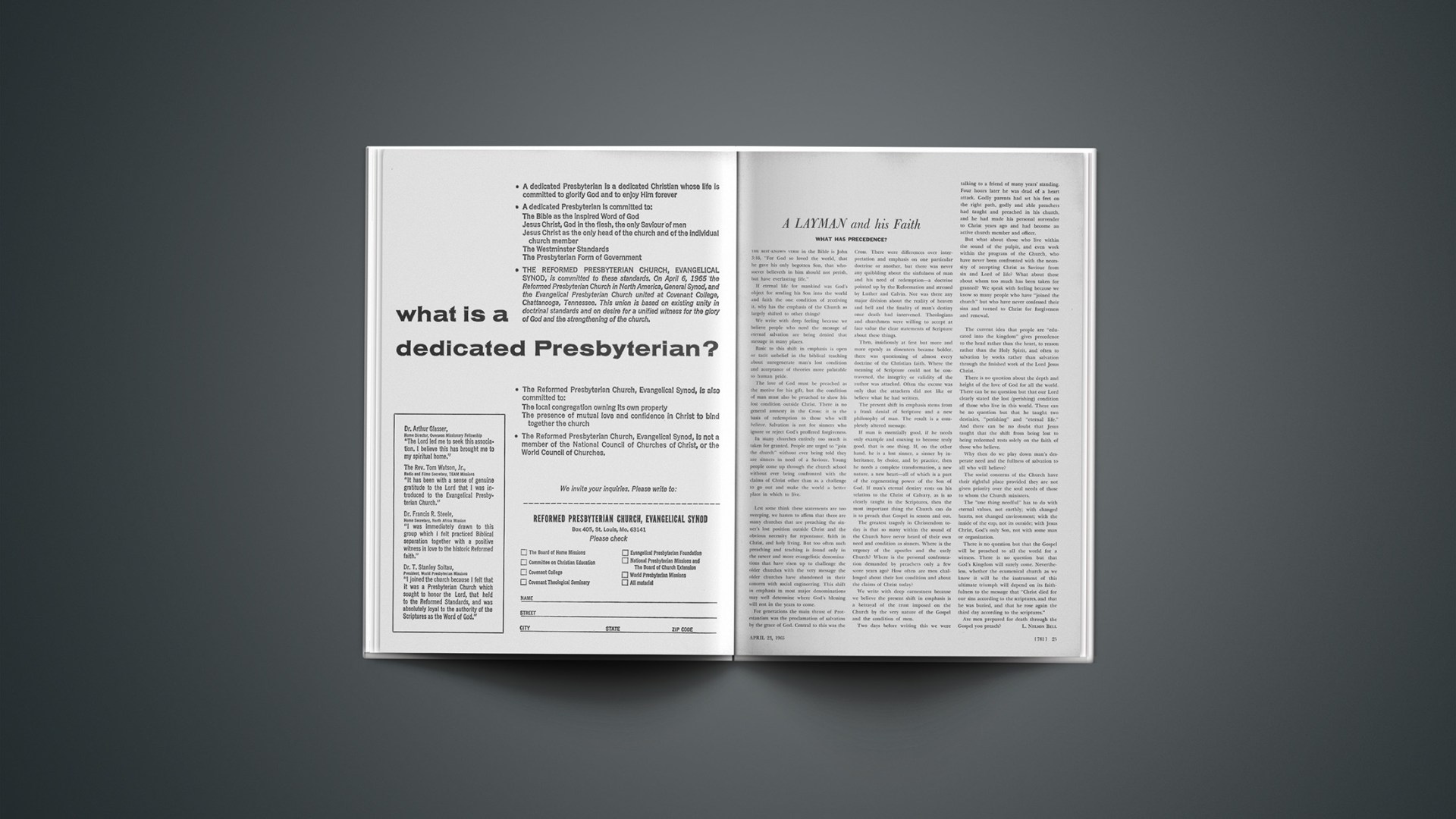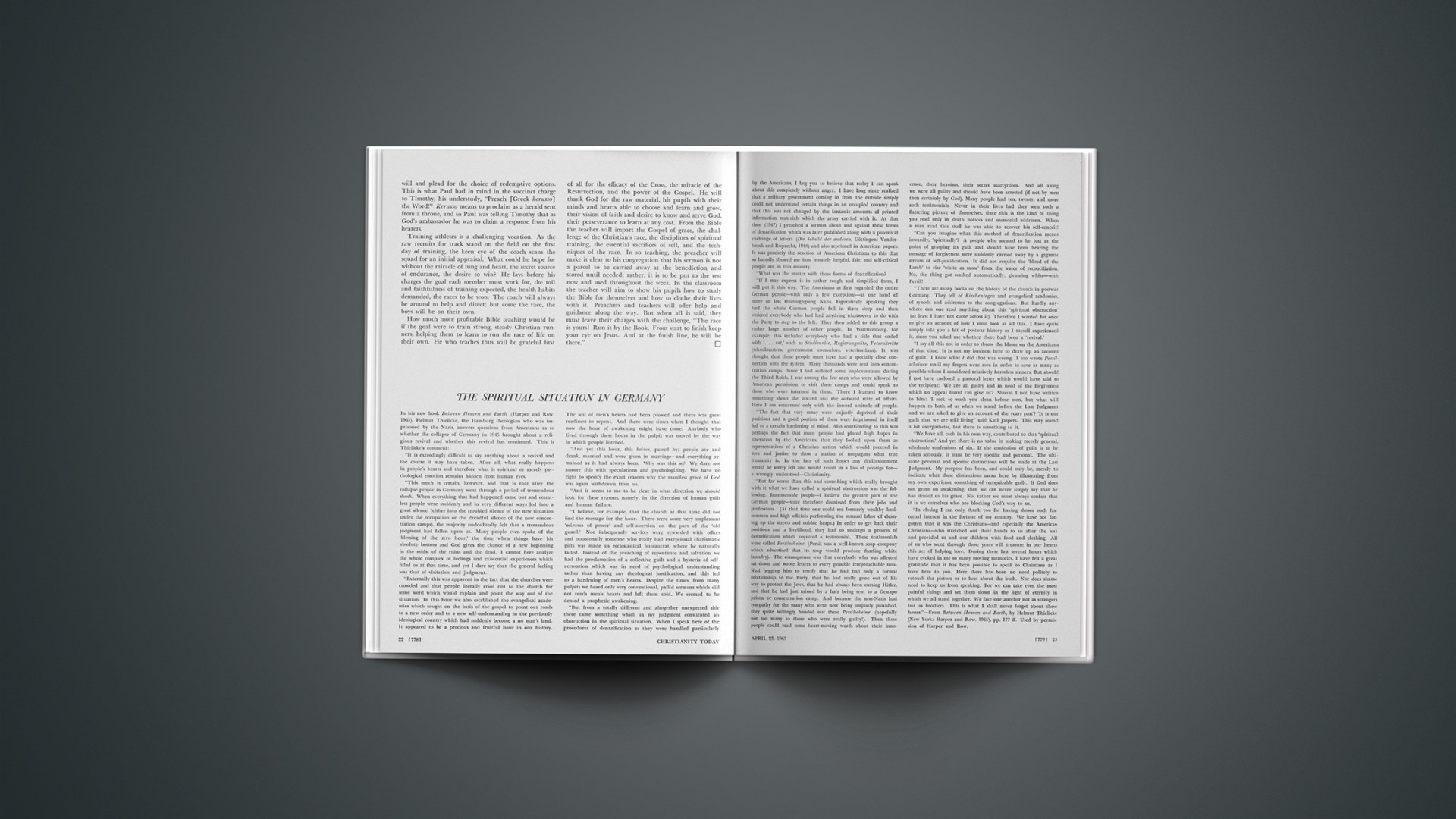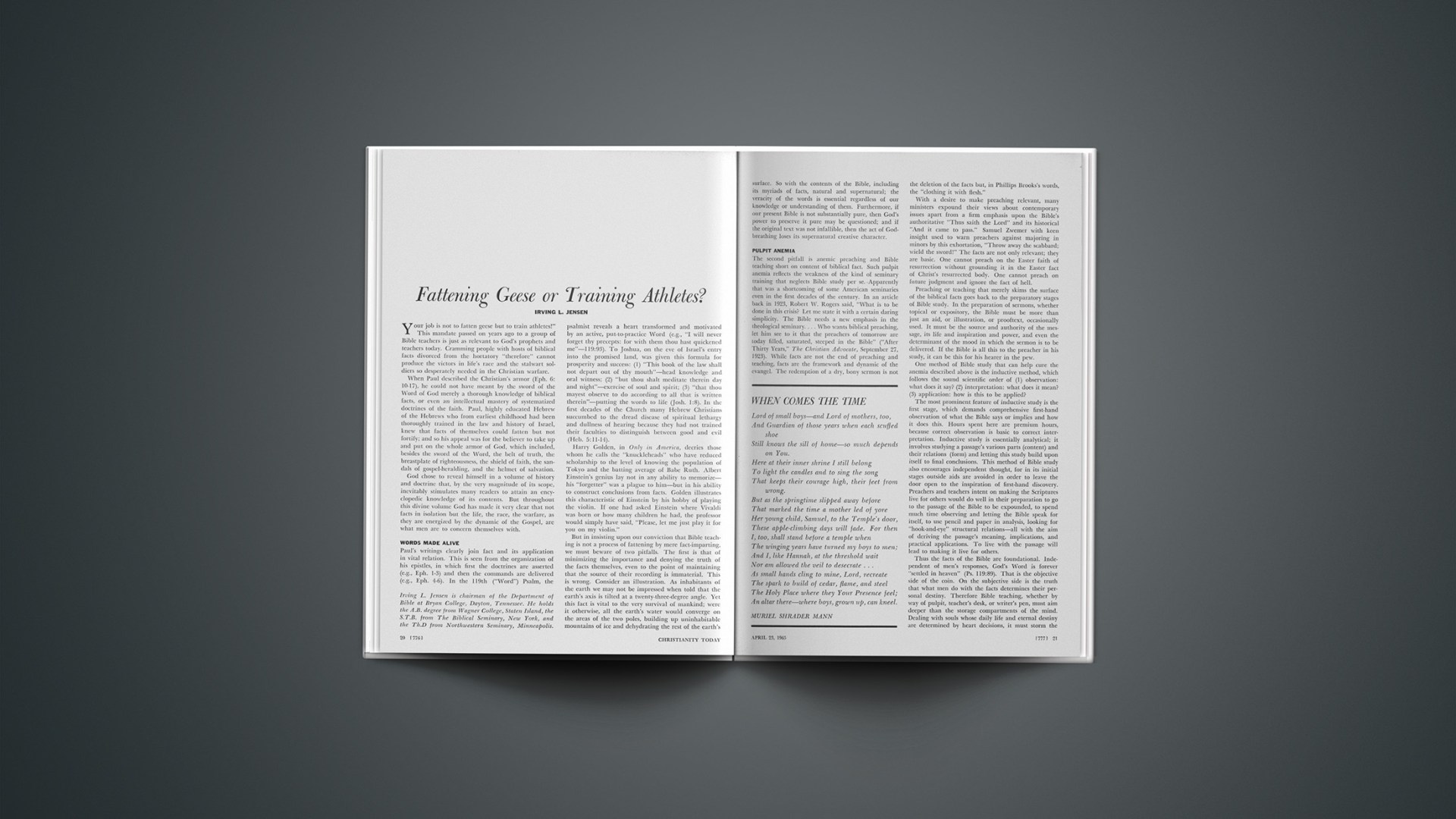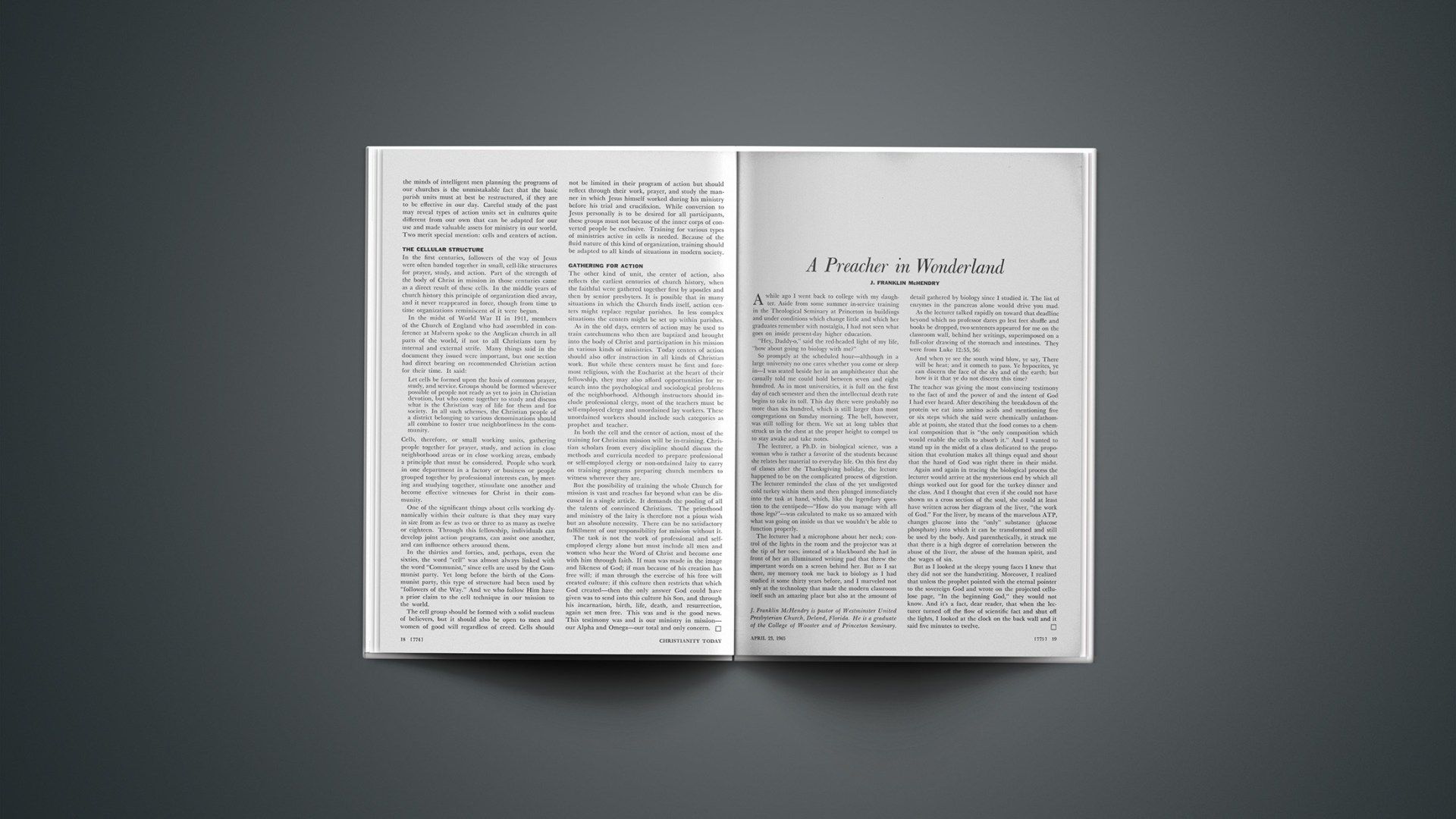READING FROM LEFT TO RIGHT
The words of David B. Truman, dean of Columbia: “We are in danger of producing a generation that has spent more years than its predecessors in educational institutions but has not gained the kind of literacy that was once regarded as the mark of an educated man.”
Having read this I wondered why. At the same time I picked up a bibliography of readings put out by the National Education Association of Washington, D. C. There were fifty-two titles on the list as well as a note promising more of the same if you wanted it.
Listen to some of the titles. Experiments in Independent Reading, Guiding Children’s Reading through Experience, The Improvement of Reading, On and On in Reading, Growing into Reading, and the prize of them all, Readings on Reading. And so it goes for all fifty-two titles.
It has been one of my basic beliefs that the best teaching in the whole educational scheme is done by those wonderfully devoted women in the first and second grades. From my own experience and that of people I know, I surely have no complaints with what they get done year after year. What worries me is how any sober teacher of integrity can possibly “keep up” with a bibliography of fifty-two books on just the subject of reading. Furthermore, is reading really so tough? And furthermore, do you get the suspicion I do—that most of what is listed on a bibliography is there because too many people have to “publish or perish” or because there is nothing more impressive to a certain level of educated mind than a mimeographed bibliography? This sort of thing can push us eventually to a twentieth-century Tower of Babel.
As an old McGuffey Reader fan, I am more interested in content than in technique, in big ideas than in controlled vocabularies. And what I say goes also for too much stuff under the general heading of Christian education. Our much “learning” will make us mad.
SELMA
As one who has had frequent occasion in the past to be critical of your stand on social issues, I would like to thank you for the forthrightness of your editorial “Flood Tide in Selma” (Mar. 26 issue), and commend you for the vigor with which you spoke.
Certainly the events since the tragic march of March 7 have indicated that the Church is at long last irrevocably involved in the civil rights struggle, and we must all hope that this is one point where we can unambiguously make common cause together, regardless of what things may separate us elsewhere.
Professor of Religion
Stanford University
Stanford, Calif.
Only the ultimate in ecclesiastical arrogance would compel a minister to brazenly assume that he must leave the subways, Central Parks, blood-bathed streets, the Harlems, canceled basketball tournaments, narcotics, political corruption, obscenity by the barrels, racial gang wars, etc., etc., ad nauseam, and come to “wicked ole Alabama” and set our house in order.…
You have problems in the Northern cities, and our prayers, sympathy, and Christian understanding go out to you. We are not going to parade in your streets (how long would I as a white Southern minister last demonstrating in Detroit?), make mockery of the cause of Christ, arrogantly enter your communities and rudely set your efforts in reverse, and create a distorted image of your community.…
First Baptist Church
Andalusia, Ala.
Prayer is to be made in the quiet of one’s own closet, not for show in the streets.… Birmingham, Ala.
Most of these traveling troubleshooters have a record behind them of subversive activities in some front organization.…
Church of the Nazarene
Port St. Joe, Fla.
You have done an excellent job of canonizing James J. Reeb, the Selma victim. I suggest, however, that Mr. Reeb is not a martyred saint, but a murdered sinner.…
I suggest turning to the Book of Philemon and reading where Paul … sent a slave, who was deprived of his civil rights, back to his master.
Certainly no one would suggest that Paul endorsed slavery. Paul believed, just as James Reeb, that Onesimus stood on equal footing of equality before the Lord and his fellow man (by right if not in fact); he believed in civil rights. But he didn’t call his fellow preachers and march on the house of Philemon. He took the only legal recourse—he sent the slave home, not because he condoned slavery, but because he condemned lawlessness.
Mr. Reeb had been participating in and encouraging civil disobedience. His death is tragic, shameful, and sinful. But his actions were inexcusable in spite of this.…
County Line Church of Christ
Axton, Va.
Those who have protested voting irregularities in the South have yet to register their protest about voting irregularities in Chicago. Brutality in Alabama has stirred them to action, but there were no marches for the martyred missionaries of the Congo who were brutally attacked by Communist cannibals.… These lovers of mankind mourn when a meddling Unitarian is murdered, but have not one tear to shed when a policeman gives his life in the line of duty. These people will parade before news-reel cameras when some American in this country is deprived of his rights, but they will not protest, parade, nor petition the President for that uncounted number of Americans who have been deprived of all their rights because they are forcibly detained by Communist governments. Does not this consistent pattern of inconsistent demonstrating betray the demonstrators?
Ashburn Baptist
Chicago, Ill.
Though I do not always agree with your point of view I want to express to you my deep gratitude for your most perceptive and forthright editorial.… In this expression of Christian concern for the tragedy in Selma, Alabama, you have evinced the prophetic sensitivity which certainly ought to characterize Christians of all theological views. May I therefore indicate to you my gratitude for your forthrightness, indeed rightness, of this statement.
Department of Preaching and Worship
Saint Paul School of Theology
Kansas City, Mo.
We must remember that the Scriptures not only teach “brotherhood” for the Church, but we are also enjoined to “do good to all men,” which makes those who are supporting civil injustice, and white supremacy, to be actively against that which is right, and just.…
How can missionary work succeed, when those who claim to be the champions of fundamental Christianity are beaming their anti-Negro, anti-civil-rights programs to Africa and other parts of the world, in support of white supremacy against the less privileged races?
Berlin Bible Church
Narrowsburg, N.Y.
Re “The Clergy March on Alabama” (News, Mar. 26 issue): True, it would have been better if Alabama clergymen, or better still, lay churchmen, had taken up the cause of Alabama Negroes. The stark truth is that they remained silent along with “the host of evangelicals in America.”
Who was to break the silence? The local white power structure had already passed by on the other side of the street. They may have deplored the circumstances of Negroes, but, even more, they were afraid to break the social mores of the South and to suffer social crucifixion. In this day of mass communication the other side of the street is brought as close as our television screen. Men of compassion, clergy and laymen alike, responded to the Alabama tragedy as readily as the good Samaritan.
As for the fear of ecclesiastical examples being set on the side of civil disobedience, it seems that evangelical Protestants have short memories. The birth of Protestantism was cradled in civil disobedience; and so was the birth of America. At the time it happened it was said that man’s law was being broken for the sake of the higher law of God. Why are the so-called followers of One who so clearly led the way over and beyond social conformity afraid to break the unjust traditions of our nation?
Dir. of Adult Program
Central YMCA
Philadelphia, Pa.
Mr. James Reeb would still be alive today if he had been minding his business in Boston, helping the underprivileged people, instead of going in a “totalitarian atmosphere instructed by Martin Luther King.”
I lived in east Tennessee for several years, and I believe I can understand both sides of this issue a little better than if I had never lived there. “Taking from the haves and giving to the have-nots” is anti-freedom, anti-Christian, and anti-American.…
Educational Director
Taylor Street Church of Christ
Hobbs, N. M.
Could it be that “evangelicals in America who remained silent” about events in Selma remained silent because of embarrassment! Have we not been caught in the embarrassing position of sending our young people to colleges where segregation is taught (i.e., Bob Jones University, where Governor George Wallace was awarded an honorary doctor’s degree last year)? Perhaps we are silent because we use ministers in our conference circuits whose churches practice segregation. Perhaps it’s the beam in our own eye that keeps us silent.
If Dr. King uses “fantastic prooftexting,” great segments of evangelical Christianity practice segregation based on a misuse of Scripture. Ought we not to raise our voices and call this fantastic?…
Hartford, Conn.
Selma has very, very fine reserved people—Christian people who have behaved exceptionally well under these trying circumstances.
We have no hate for the Negro, and they are treated well.…
Huntsville, Ala.
When whites, especially Southern whites, decide that they are fully as good as the blacks, the entire problem will be better prepared for dissolution. In any 100-year period, when have the Caucasians come as far and as fast as the Negroes?
Bloomsburg, Pa.
There is much truth in “Selma: Parable of the Old South” (News, Mar. 12 issue). But there is one fact which the whole country knows, but which I have never seen hinted at in any publication, North or South.
It harks back to colonial days, and both North and South are implicated. Many white men—I fear a decided majority of them—exploited the Negro women to mix the races. Many Negroes in this country are blood-relations of the old Southern aristocracy; and as sons of their fathers, why shouldn’t they enjoy the standing, socially and nationally of their fathers?
Incidentally, I do not think it is pleasing to God for races to mix.… I am reminded here of Micah 7:6: “… the son dishonoreth the father.… A man’s enemies are the men of his own house.” Doubtless this applies to the Northern man as well as the man of the South.
A second fact: … The North, during Reconstruction days, in order to humiliate the South as much as possible, proceeded to put, or try to put, the Negroes above the defeated white man—which was a bit galling to the Southerners. By this the “Yankees” dropped the “seed” of hatred and rebellion, and the “harvest season” is now. It also prevented, or greatly delayed, a feeling of brotherhood between the North and the South.
High Point, N. C.
The Communists have been very discouraged about the smooth way the South has handled all their heckling. But, to get justifiable scenes and reports, they excite “outsiders” to add to the confusion and to make a killing so they can praise a martyr.…
Steelville, Mo.
The white clergy want things done “gradually”—what do they mean? Isn’t 100 years gradual enough? Any honest person will admit that the white race in the South will never move one inch except when forced to do so.…
Ann Arbor, Mich.
EMPTY TOMB AND EARLY CHURCH
Thank you for the fine discussion, “Faith, History, and the Resurrection” (Mar. 26 issue). I would simply like to question Professor Moreau’s last statement that “preoccupation with the facticity of … the resurrection … is quite foreign to the attitude of the early Church.”
In Matthew 28:6, the angel not only says, “He is not here; for he has risen, as he said,” but also, “Come, see the place where he lay. Then go quickly and tell his disciples that he has risen from the dead.” Certainly the “Come see …” serves a verificational purpose as well as an apologetic. (I see no way to set these purposes in antithesis as Professor Moreau does.) Mark 16:6 also has this “see the place where they laid him.” What else is this but an appeal for them to believe that the resurrection of Jesus was a historical fact?
What is the point of Luke 24:11, “these words seemed to them an idle tale, and they did not believe them,” but to set up the problem of verification? And, if we skip verse 12 as being textually insecure, what is the point of verses 36–43, the “see my hands and my feet” and “handle me and see” and the eating of physical food before them, except to verify to them the facticity of a bodily resurrection.…
Philadelphia, Pa.
Wonder how much the average layman would profit by such a discourse. It would seem that each one of the speakers tries his best to outdo the previous one in hairsplitting.…
Minneapolis, Minn.
I am particularly enjoying the current issue of CHRISTIANITY TODAY and your discussion on “Faith, History, and the Resurrection”.…
Park Avenue Methodist Church
Minneapolis, Minn.
WHEN REASONING IS FOOLISH
In reference to J. G. M.’s article, “Is the Bible the Word of God?” (Mar. 26 issue): The Authorized King James version of 1611 of the original Greek and Hebrew Holy Scriptures is perfect and without error—in other words, infallible.
The same Holy Ghost that inspired the eight writers of the Greek New Testament to protect them from error was also with the scribe who reproduced the original script (“autograph”) and the subsequent scribe who reproduced the reproduction until the invention of printing. The same Holy Ghost was with the authorized King James revisers who relied quite heavily on William Tyndale’s translation from the Greek into the English in 1525.
A man is inspired by God when he is being used by Him to fulfill one of His acts but usually erring much of the rest of the time when dealing in earthly matters. To reason any other way is foolish—and dangerous.
The Authorized King James is the only true English version of the Holy Scriptures. Covina, Calif.
TWIG BENDS, LIGHT DOESN’T
Allow me to point out a scientific error in Dr. Bell’s contribution for March 12.
The property of bending light to go around corners is properly called “fiber optics.” Actually the light is not bent. When light enters an elongated body of high refractive index such as the plastic, methyl methacrylate, known commercially as Lucite or Plexiglass, the light tends to be confined within the walls of the body in the same way as water is within a pipe. Thus, it is possible to view one end of a bundle of rods of this material and see an object placed in front of the opposite end of the bundle, even though the bundle might be tied in a knot as mentioned.
The laser has no relation to fiber optics. Ordinary light tends to diffuse in all directions, as ripples extend out from a stone dropped in a pond. By the use of lenses or mirrors, light can be directed in a more confined path. However the laser concentrates and intensifies light in much more intense manner so that the narrow beam possesses the high energy needed to weld detached retinas, bore holes in steel, etc. The ability of a magnifying glass to gather light to a point is commonplace. The laser gathers light also, but directs it into a beam rather than a spot.
Each of the two phenomena mentioned by Dr. Bell affords interesting object lessons in various areas of life, but if they are not kept in their proper places, they produce a confused impression.
Washington, D. C.
TO RESTORE THE CHURCHILLIAN
Perhaps I ought to be the first to point out that the quotation from Churchill in my recent letter (Mar. 12 issue) was garbled so as to begin: “We regret with scorn.…” That, it seems to me, is not at all Churchillian, and it weakens the whole statement. What he really said was “We reject.…”
The Lutheran Church of Our Redeemer
Peekskill, N.Y.
A WAY THROUGH THE WOOD
Thank you for your magnificent series of articles on contemporary European theological trends.… I could not begin to tell you how this has provided for me (and, I am sure, for countless others) a “way through the wood,” and provided us with a completely new kind of enlightenment on the theological issues with which we are involved.…
Glasgow, Scotland
The articles on contemporary European theology [provide] an excellent historical survey.…
Baker Book House
Grand Rapids, Mich.
It is obvious that these theologians are drowning in their own verbiage and at the same time are dragging down with them many innocent victims, especially young seminarians.…
WEST LEBANON, N. Y.
Comment on the anarchy of present-day theological thought: Every man thought according to what seemed right in his own eyes (compare Judges 17:6).
Lookout Mountain, Tenn.
AND TODAY IT’S JAFFA
Dr. J. Lester Harnish [in] “Keep Those Windows Open” (Jan. 29 issue) stated that he attended church services in Haifa in a church that had been built in the … [traditional] spot where Simon the tanner had his house.… My Bible states that Simon the tanner lived in Joppa and that is where Peter had his vision.… Minnetonka, Minn.
FRIENDLY CORRECTION
We are interested in the article by Harold B. Kuhn about the Society of Friends appearing in your issue of February 26. We should like to call the attention of Harold Kuhn, and of your readers also, to two statements in that article which we believe are somewhat misleading. The first is that “General Conference Friends” have been absorbed “into groups of Friends formerly labeled ‘orthodox.’ ” This is not true. Friends belonging to Friends General Conference were not absorbed into the former “orthodox” group. What has happened is that within the last ten years in a number of sections of the country formerly divided groups of Friends have reunited as equals, but Friends General Conference has very far from disappeared. It is, in fact, now the central organization holding together at least 32,000 Friends in many parts of the United States.
The other statement that we question is the one saying that Quaker Life is the major publication of the Society of Friends. It is true that Quaker Life is the official publication of the Five Years Meeting of Friends and is an excellent magazine, but Friends Journal, sponsored by Friends General Conference, is, I believe, an equally influential organ of present-day Quakerism.…
Friends Journal
Editor
Philadelphia, Pa.
WEARY OF WAITING
Dr. Wayne Dehoney (Jan. 29 issue) is no doubt right in his judgment that “Southern Baptists have generally believed that the ultimate objective of the current ecumenical thrust is organic union.” Yet there are many Southern Baptists who know that this is not the case and who respect the National Council’s intent as stated in its constitution, that “the Council shall have no authority … to limit the autonomy of the churches cooperating with it.”
It is unfortunate that Dr. Dehoney failed to mention one of the main reasons why Southern Baptists have been wary of the ecumenical movement. We have been afraid to speak out on controversial issues, whereas the National Council has had the courage to relate Christianity to the controversial issues of the day. We have been intimidated against applying the implications of our faith to the racial revolution all around us. Yet it is far easier to oppose the ecumenical movement on theological grounds than to confess this failing.
I am confident that I speak for an increasing number of Southern Baptists who are weary of waiting for our denomination to join hands with the larger Christian community.
Olin T. Binkley Memorial Baptist
Chapel Hill, N.C.
DIMINISHING RETURNS
For many years I have heard vigorous discussion on both sides of the question, “Do pastors belong in politics?” Some of your readers concerned with finding an answer might find some food for thought in this story:
Last summer a local pastor was holding a successful revival in a rural section in the South. In fact, he finished up the first week by baptizing eighteen converts. But because the local election was a week away and he was seeking office, he cut the revival effort short and went out electioneering. When the election was over he had received only eight votes in the community where he had baptized eighteen less than a week before.
Bergenfield, N.J.

